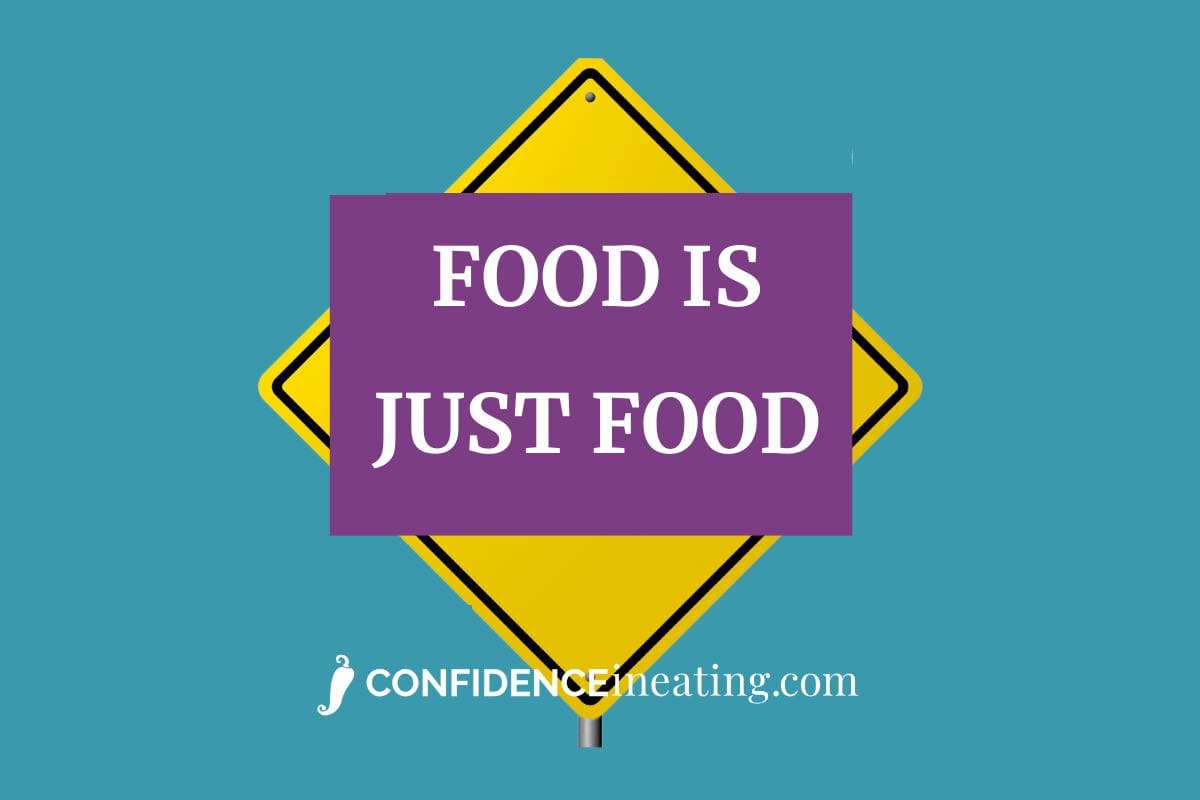You may have heard that there are bad foods to stay away from.
But this statement is just not true.
Foods often considered “bad” by some people are typically foods that are higher in calories or come in a package. But using a blanket statement about a food’s quality is a far too simple classification to use.
To understand good or bad food, let’s define what most people mean when they label food good or bad.
What is considered good or bad food?
Foods identified as good or bad are typically categorized based on the potential health benefits or perceived lack of healthful qualities.
Most people would agree that vegetables are considered “good” food. Yet a vegetable by itself is not necessarily good for everyone.
In addition, “bad” food is considered by some to be foods with higher calories, fat, or carb grams, come in packages or might have some level of processing. For example, many people believe ice cream, chips, and chocolate are bad. YIKES!
Would you really want to live without chocolate!?
Good news, you don’t have to, keep on reading and you will understand why.
Why is food classified as good or bad
Food is classified into categories in order to make general, simple recommendations on how to eat. But honestly, who really needs to know they should eat their fruits and vegetables? Most people know that fruits and vegetables have nutrients in them and there are other foods that do not have as many nutrient benefits.
There are far more factors to consider when determining if food is right for a person.
Common reasons food is labeled as good or bad
- Fad diet guidelines
- Media outlets summarizing news stories
- Supplement companies selling their products
- Salespeople selling books, food products, and programs
- A person struggling with an eating disorder justifying the food qualities
- General recommendations that simplify and summarize general overall dietary patterns
Believing that foods fall into good or bad food categories contributes to the misunderstanding of what balancing food intake looks like. Labelling just creates more confusion about what a person should eat, which is not helpful.
Common reasons the labeling of foods good and bad is not helpful.
Let’s look at some examples of how labeling food as good or bad is not helpful by starting with fad diet guidelines. These tend to overgeneralize and simplify this.
For example, If you are following a keto diet, you hear recommendations to lower your grains, fruits, and many vegetables.

This guideline would mean “grains, fruits, and many vegetables” would be considered “bad.” This bad designation only falls under the labeling for how these foods fit under the keto guidelines. This labeling simplifies the fact that these foods have a lot of nutrients in them such as fiber, vitamins, and minerals.
How would eliminating foods with fiber, vitamins, and minerals be a good thing for a person? Only under an overgeneralized approach would this even make sense.
Nutrition and health are complex subjects. Even a basic nutrition college course is a semester-long class that only scratches the surface of the basics of nutrition.
The problem with classifying foods as good or bad
When we classify foods as good or bad, it creates an inaccurate judgment system. People will use this system to evaluate how they are doing with their nutrition. The judgment of a person for the consumption of food and the qualities of that food can not be minimized to that food as being good or bad.
This judgment perspective says that if you eat more “good” foods and less “bad” foods, you are doing good. However, this narrow view of how a person is doing nutritionally misses the whole big picture that all foods combined over time create the reality of how a person is doing with meeting nutrition guidelines.
The number of bad foods does not determine the nutritional status
You cannot tell how a person is doing nutritionally just by the number of foods eaten in the “good” or “bad” category. For comparison, when I do a thorough assessment of my clients in the platinum program, the assessment takes about three hours to complete in order to get a good picture of how a person is doing nutritionally.
While the idea that meeting nutrition guidelines translates into improved health, this line of thinking also must consider multiple factors.
The key when considering how “good” and “bad” foods work for a person and how they are doing is to look at the time span.
After all, what matters most when it comes to nutrition, is the sum of the dietary patterns and choices with trends over time.
The challenge is that the food and nutrition picture is not so simple.
So, what is the impact of eating good or bad food
There is no big magical power that happens with eating one food or even several foods at one time.
Food is not moral, and you are not good or bad for eating food that falls into a particular category.
Even though you may hear people talk about being “good” or “bad” for eating certain foods, judging this way is not needed.
The feeling of accomplishment some people equate to eating foods that are “good” or “bad” just does not equate to as much as one might think. You know what I mean, while you may have been praised for eating all your peas and carrots as a kid, you don’t get any gratification like that as an adult. As if somehow eating your peas and carrots would make you a better person!
In the same manner, eating a cupcake does not make you a bad person or mean you are bad. Likewise, eating a salad does not mean you are good.
Here’s the moral of the story about good food and bad food.
There is no such thing as good or bad food! Food is meant to help fuel your body as well as for you to enjoy.
If you feel like you have a love/hate relationship with food and wonder “Why I can’t stop eating”, the way you think about food may be the problem.
Remember, “chocolate fits in a “healthy meal” plan”.
If you would like some support with your nutrition approach and want to learn how you can eat all foods in a healthy nutrition plan, schedule a discovery call with me to find out how we can support your goals.
Discover if your binge eating is a concern by taking our free Binge Eating Quiz today and learn what your next steps are to feel more in control of your eating.





